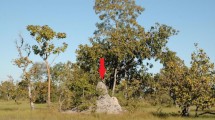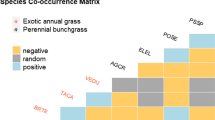Abstract
We examined the entire spatial distribution of a narrow endemic shrub (Coccoloba cereifera, Polygonaceae) in Serra do Cipó, Brazil. We tested the hypothesis that a narrow endemic species would show a gradual decline in either size and density towards the edges of its distribution. The contribution of soil specificity and post-fire growth to C. cereifera abundance and distribution were also investigated. C. cereifera showed multimodal and highly aggregated distribution pattern at several scales, from 25 m2 to 3000 m2 (blocked quadrat variance analyses). This pattern seems to be strongly related to the predominance of clonal recruitment and to the close association of the species to sandfields, which have discrete distribution between gallery forests and rocky outcrops. Population density did not decline towards the edge of the species distribution. Plants near the distribution boundaries had slightly more leaves and more inflorescences per plant (p<0.005), but there was no significant change in the mean number of ramets per clone. The absence of large plants in some populations at the center of the species distribution may be related to the higher frequency of fire in this region, killing aerial plant parts. Nearly all aggregations had inverse-J shaped size-distribution, suggesting effective recruitment of ramets, most frequently via asexual reproduction. Similar patterns of plant abundance may be common in fire-prone habitats characterized by infertile, and well-drained soils since these areas generally have high numbers of endemic plants, with strong soil specificity. Possible mechanisms for the observed pattern are discussed considering current models concerning distribution of abundance of species.
Similar content being viewed by others
References
Abrahamson, W. G. & Abrahamson, C. R. 1996. Effects of fire on long unburned Florida uplands. J. Veg. Sci. 7: 565–574.
Anderson, D.J. 1986. Ecological succession. Pp. 269–285. In: Kikkawa, J. & Anderson, D.J. (eds), Community ecology: pattern and process. Blackwell Scientific Publications, Oxford.
Babbel, G. R. & Selander, R. K. 1974. Genetic variability in edaphically restricted and widespread plant species. Evolution 28: 619–630.
Baskauf, C. J. & Eickmeier, W. G. 1994. Comparative ecophysiology of a rare and a widespread species of Echinacea (Asteraceae). Am. J. Bot. 81: 958–964.
Begon, M., Harper, J. L. & Townsend, C. R. 1986. Ecology: Individuals, populations and communities. Blackwell, Oxford.
Bond, W. J. & van Wilgen, B. W. 1996. Fire and plants. Population and community biology series. Chapman & Hall, London.
Brown, J. H. 1984. On the relationship between abundance and distribution of species. Am. Nat. 124: 255–279.
Brown, J. H. 1995. Macroecology. The University of Chicago Press, Chicago.
Brown, J. H., Mehlman, D. W. & Stevens, G. C. 1995. Spatial variation in abundance. Ecology 76: 2028–2043.
Carter, R. N. & Prince, S. D. 1988. Distribution limits from a demographic viewpoint. Pp. 59–82. In: Davy, A. J., Hutchings, M. J. & Watkinson, A. R. (eds), Plant Population Ecology. Blackwell Scientific Publications, Oxford.
Caughley, G., Grice, D., Barker, R. & Brown, B. 1988. The edge of the range. J. Anim. Ecol. 57: 771–785.
Coutinho, L. M. 1990. Fire in the ecology of the Brazilian Cerrado. Pp. 82–105. In: Goldhammer, J.G. (ed.), Fire in the tropical biota. Springer-Verlag, Berlin.
Cowling, R. M., Witkowski, E. T. F., Milewski, A. V. & Newbey, K. R. 1994. Taxonomic, edaphic and biological aspects of narrow plant endemism on matched sites in Mediterranean South Africa and Australia. J. Biog. 21: 651–664.
Drury, W. H. 1980. Rare species of plants. Rhodora 82: 3–48.
Freitas, F. G. & C. O. Silveira 1977. Principais solos sob vegetação de cerrado e sua aptidão agrícola. Pp. 405. In: Ferri, M. G. (ed.), IV Simpósio sobre o Cerrado -Bases para Utilização Agropecuária. EDUSP/Itatiaia, São Paulo.
Galvã o, M. V. & Nimer, E. 1965. Clima. Pp. 91–139. In: IBGE (ed.), Geografia do Brasil -Grande Regiã o Leste, 5. IBGE, Rio de Janeiro.
Gentry, A. H. 1986. Endemism in tropical versus temperate plant communities. Pp. 153–181. In: Soulé, M. E. (ed.), Conservation biology: the science of scarcity and diversity. Sinauer, Sunderland.
Giulietti, A. M., Menezes, N. A, Pirani, J. R., Meguro, M. & Vanderley, M. G. L. 1987. Flora da Serra do Cipó : caracterizaç ã o e lista de espécies. Bol. Bot. 9: 1–151.
Grubb, P. J. 1977. The maintenance of species richness in plant communities: the importance of the regeneration niche. Biol. Rev. 52: 107–145.
Hanski, I. 1994. A practical model of metapopulation dynamics. J. An. Ecol. 63: 151–162.
Hassel, M. P. & May, R. M. 1974. Aggregation of predators and insect parasites and its effects on stability. J. An. Ecol. 43: 567–594.
Hill, M. O. 1973. The intensity of spatial pattern in plant communities. J. Ecol. 61: 225–235.
Hoffman, W. A. 1998. Post-burn reproduction of woody plants in a neotropical savanna: the relative importance of sexual and vegetative reproduction. J. Appl. Ecol. 35: 422–433.
Howard, R. A. 1960. Studies in the genus Coccoloba IX. A critique of the South American species. J. Arn. Arb. 41: 213–258.
Huffaker, C. B. 1958. Experimental studies on predation: dispersion factors and predator-prey oscillations. Hilgardia 27: 343–383.
Hutchinson, G. E. 1957. Concluding remarks. Quart. Rev. Biol. 22: 415–427.
Kareiva, P. 1986. Patchiness, dispersal, and species interactions: consequences for communities of herbivorous insects. Pp. 192–206. In: Diamond, J. & Case, T. J. (eds), Community ecology. Harper & Row, New York.
Kruckeberg, A. R. & Rabinowitz, D. 1985. Biological aspects of endemism in higher plants. Ann. Rev. Ecol. Syst. 16: 447–479.
Kunin, W. E. & Gaston, K. J. (eds.) 1997. The biology of rarity. Chapman & Hall, London.
Lawton, J. H. 1993. Range, population abundance and conservation. TREE 8: 409–413.
Ludwig, J. A. & Reynolds, J. F. 1988. Statistical ecology. Wiley, New York.
Major, J. 1988. Endemism: a botanical perspective. Pp. 117–146. In: Myers, A. A. & Giller, P. S. (eds), Analytical biogeography: an integrated approach to the study of animal and plant distributions. Chapman & Hall, London.
May, R. M. 1975. Patterns of species abundance and diversity. Pp. 81–120. In: Cody, M. L. & Diamond, J. M. (eds), Ecology and evolution of communities. Harvard University Press, Cambridge.
McDonald, D. J., Juritz. J. M., Cowling, R. M. & Knottenbelt, W. J. 1995. Modeling the biological aspects of local endemism in South African fynbos. Pl. Syst. Evol. 195: 137–147.
Pate, J. S. 1993. Structural and functional responses to fire and nutrient stress: case studies from the sandplains of south-west Australia. Pp. 189–205. In: Fowden, L., Mansfield, T. & Stoddart, J. (eds), Plant adaptation to environmental stress. Chapman & Hall, London.
Prance, G. T. 1987. Biogeography of neotropical plants. Pp. 46–65. In: Whitmore, T. C. & Prance, G. T. (eds), Biogeography and quaternary history in tropical America. Clarendon Press, Oxford.
Pulliam, H. R. 1988. Sources, sinks, and population regulation. Am. Nat. 137: 550–60.
Rabinowitz, D., Cairns, S. & Dillon, T. 1986. Seven forms of rarity and their frequency in the flora of the British islands. Pp. 182–204. In: Soulé, M. E. (ed.), Conservation biology: the science of scarcity and diversity. Sinauer, Sunderland.
Rapoport, E. H. 1982. Areography: Geographical strategies of species. Pergamon Press, Oxford.
Ribeiro, K. T. & Fernandes, G. W. Geographic distribution of Coccoloba cereifera (Polygonaceae), a narrow endemic from Serra do Cipó , Brazil. Bios. (in press).
Rizzini, C. T. 1979. Tratado de fitogeografia do Brasil. Vol. 2. Hucitec/EDUSP, Sã o Paulo.
Schutte, A. L., Vlok, J. H. J. & Van Wyk, B.-E. 1995. Fire-survival strategy -a character of taxonomic, ecological and evolutionary importance in fynbos legumes. Pl. Syst. Evol. 195: 243–259.
Simberloff, D. & Cox, J. 1987. Consequences and costs of conservation corridors. Cons. Biol. 1: 63–71.
Sokal, R. R. & Rohlf, F. J. 1995. Biometry. Freeman, New York.
Taylor, R. A. J. & Taylor, L. R. 1977. A behavioral model for the evolution of spatial dynamics. Pp. 1–27. In: Anderson, R. M., B. D. Turner, B. D. & Taylor, L. R. (eds), Population dynamics. Blackwell, Oxford.
Whelan, R. J. 1995. The ecology of fire. Cambridge University Press, Cambridge.
Whittaker, R. H. 1956. Vegetation of the Great Smoky Mountains. Ecol. Monogr. 22: 1–44.
Zammit, C. 1988. Dynamics of resprouting in the lignotuberous shrub Banksia oblongifolia. J. Ecol. 13: 311–320.
Author information
Authors and Affiliations
Rights and permissions
About this article
Cite this article
Ribeiro, K.T., Wilson Fernandes, G. Patterns of abundance of a narrow endemic species in a tropical and infertile montane habitat. Plant Ecology 147, 205–217 (2000). https://doi.org/10.1023/A:1009883300536
Issue Date:
DOI: https://doi.org/10.1023/A:1009883300536




